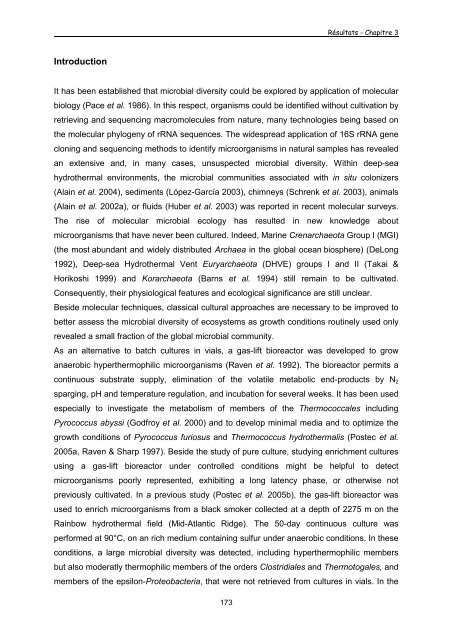THESE Anne POSTEC Diversité de populations microbiennes ...
THESE Anne POSTEC Diversité de populations microbiennes ...
THESE Anne POSTEC Diversité de populations microbiennes ...
Create successful ePaper yourself
Turn your PDF publications into a flip-book with our unique Google optimized e-Paper software.
Résultats - Chapitre 3<br />
Introduction<br />
It has been established that microbial diversity could be explored by application of molecular<br />
biology (Pace et al. 1986). In this respect, organisms could be i<strong>de</strong>ntified without cultivation by<br />
retrieving and sequencing macromolecules from nature, many technologies being based on<br />
the molecular phylogeny of rRNA sequences. The wi<strong>de</strong>spread application of 16S rRNA gene<br />
cloning and sequencing methods to i<strong>de</strong>ntify microorganisms in natural samples has revealed<br />
an extensive and, in many cases, unsuspected microbial diversity. Within <strong>de</strong>ep-sea<br />
hydrothermal environments, the microbial communities associated with in situ colonizers<br />
(Alain et al. 2004), sediments (López-García 2003), chimneys (Schrenk et al. 2003), animals<br />
(Alain et al. 2002a), or fluids (Huber et al. 2003) was reported in recent molecular surveys.<br />
The rise of molecular microbial ecology has resulted in new knowledge about<br />
microorganisms that have never been cultured. In<strong>de</strong>ed, Marine Crenarchaeota Group I (MGI)<br />
(the most abundant and wi<strong>de</strong>ly distributed Archaea in the global ocean biosphere) (DeLong<br />
1992), Deep-sea Hydrothermal Vent Euryarchaeota (DHVE) groups I and II (Takai &<br />
Horikoshi 1999) and Korarchaeota (Barns et al. 1994) still remain to be cultivated.<br />
Consequently, their physiological features and ecological significance are still unclear.<br />
Besi<strong>de</strong> molecular techniques, classical cultural approaches are necessary to be improved to<br />
better assess the microbial diversity of ecosystems as growth conditions routinely used only<br />
revealed a small fraction of the global microbial community.<br />
As an alternative to batch cultures in vials, a gas-lift bioreactor was <strong>de</strong>veloped to grow<br />
anaerobic hyperthermophilic microorganisms (Raven et al. 1992). The bioreactor permits a<br />
continuous substrate supply, elimination of the volatile metabolic end-products by N 2<br />
sparging, pH and temperature regulation, and incubation for several weeks. It has been used<br />
especially to investigate the metabolism of members of the Thermococcales including<br />
Pyrococcus abyssi (Godfroy et al. 2000) and to <strong>de</strong>velop minimal media and to optimize the<br />
growth conditions of Pyrococcus furiosus and Thermococcus hydrothermalis (Postec et al.<br />
2005a, Raven & Sharp 1997). Besi<strong>de</strong> the study of pure culture, studying enrichment cultures<br />
using a gas-lift bioreactor un<strong>de</strong>r controlled conditions might be helpful to <strong>de</strong>tect<br />
microorganisms poorly represented, exhibiting a long latency phase, or otherwise not<br />
previously cultivated. In a previous study (Postec et al. 2005b), the gas-lift bioreactor was<br />
used to enrich microorganisms from a black smoker collected at a <strong>de</strong>pth of 2275 m on the<br />
Rainbow hydrothermal field (Mid-Atlantic Ridge). The 50-day continuous culture was<br />
performed at 90°C, on an rich medium containing sulfur un<strong>de</strong>r anaerobic conditions. In these<br />
conditions, a large microbial diversity was <strong>de</strong>tected, including hyperthermophilic members<br />
but also mo<strong>de</strong>ratly thermophilic members of the or<strong>de</strong>rs Clostridiales and Thermotogales, and<br />
members of the epsilon-Proteobacteria, that were not retrieved from cultures in vials. In the<br />
173
















